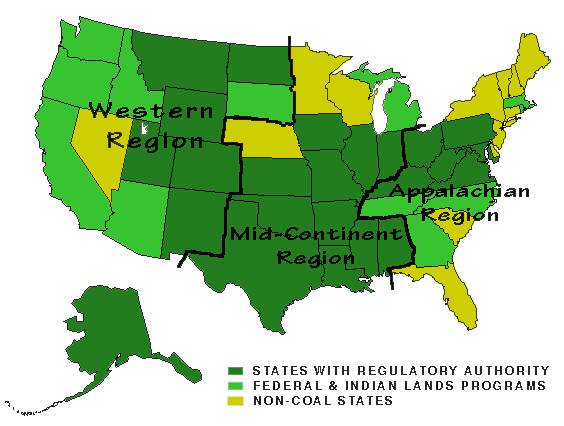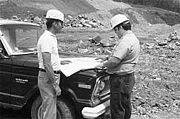
Office of Surface Mining
Encyclopedia
The Office of Surface Mining Reclamation and Enforcement (OSM or OSMRE) is a branch of the United States Department of the Interior
. It is the federal agency entrusted with the implementation and enforcement of the Surface Mining Control and Reclamation Act of 1977
(SMCRA), which attached a per-ton fee to all extracted coal in order to fund an interest-accruing trust to be used for reclamation of abandoned mine lands, as well as established a set environmental standards that mines must follow while operating, and achieve when reclaiming mined land, in order to minimize environmental impact . OSM has about 500 employees, who work in either the national office in Washington, DC or of the many regional and field offices(OSM's Three Regions). As of November 06, 2009, OSM is directed by Joe Pizarchik .
 OSM has three main functions:
OSM has three main functions:
; this includes setting regulatory guidelines. The actual regulation of mines is primarily done on a state
level and tribal level, but OSM is charged with inspection of the state programs to meet the standard of quality. OSM regularly inspects state programs to make sure they are meeting the required standards; if they do not meet the required standards the OSM can take over. For example, when in the fiscal year of 2003 Missouri
was unable to meet the federal requirements due to a lack of funding, OSM stepped in to assume partial control of the state program. OSM took control of the following in Missouri:
OSM took control of the following in Missouri:
OSM continued to run the above parts of Missouri's mining program until Missouri improved its program, which took place on Feb. 1, 2006. Missouri now receives federal funding.
. Environmental problems associated with abandoned mine lands include surface and ground water pollution, entrances to open mines, water-filled pits, unreclaimed or inadequately reclaimed refuse piles and minesites (including some with dangerous highwalls), sediment-clogged streams, damage from landslides, and fumes and surface instability resulting from mine fires and burning coal refuse. Environmental restoration activities under the abandoned mine reclamation program correct or mitigate these problems.
OSM's Bat conservation project was begun December 15, 1998 when OSM signed a MOU
with Bat Conservation International, Inc. in order to establish a framework for cooperative efforts between the two organizations to maintain and increase the conservation of bats and their habitats. Under this agreement, OSM would (1) Consider the conservation of bats and their habitats in the development and implementation of abandoned mine land (AML) reclamation standards and recommendations to States and Indian Tribes; (2) Provide assistance in the development of AML programs to help manage bats and their habitats; (3) For Federal Programs, monitor non-emergency AML shaft and portal areas for bat activity prior to reclamation; (4) As appropriate, require the use of bat gates to seal the shafts of portals where bat habitation is known and would be endangered if sealed otherwise. OSM will encourage the States and Tribes to do the same; and (5) Promote the education of OSM staff, State agencies, and Indian Tribes as to: the beneficial aspects of conserving bats, tested methods to safeguard bat habitat and public health, and ways to mitigate for loss of bat roosts and habitat.
United States Department of the Interior
The United States Department of the Interior is the United States federal executive department of the U.S. government responsible for the management and conservation of most federal land and natural resources, and the administration of programs relating to Native Americans, Alaska Natives, Native...
. It is the federal agency entrusted with the implementation and enforcement of the Surface Mining Control and Reclamation Act of 1977
Surface Mining Control and Reclamation Act of 1977
The Surface Mining Control and Reclamation Act of 1977 is the primary federal law that regulates the environmental effects of coal mining in the United States....
(SMCRA), which attached a per-ton fee to all extracted coal in order to fund an interest-accruing trust to be used for reclamation of abandoned mine lands, as well as established a set environmental standards that mines must follow while operating, and achieve when reclaiming mined land, in order to minimize environmental impact . OSM has about 500 employees, who work in either the national office in Washington, DC or of the many regional and field offices(OSM's Three Regions). As of November 06, 2009, OSM is directed by Joe Pizarchik .

- Regulating active mines
- Reclaiming lands damaged by surface mining and abandoned mines
- Providing resources for technical assistance, training, and technology development http://%5Bhttp://www.osmre.gov/science/Science.shtm%5D
Regulating Active Mines
The Office of Surface Mining is responsible for the enforcement of the Surface Mining Control and Reclamation Act of 1977Surface Mining Control and Reclamation Act of 1977
The Surface Mining Control and Reclamation Act of 1977 is the primary federal law that regulates the environmental effects of coal mining in the United States....
; this includes setting regulatory guidelines. The actual regulation of mines is primarily done on a state
State government
A state government is the government of a subnational entity in a federal form of government, which shares political power with the federal or national government. A state government may have some level of political autonomy, or be subject to the direct control of the federal government...
level and tribal level, but OSM is charged with inspection of the state programs to meet the standard of quality. OSM regularly inspects state programs to make sure they are meeting the required standards; if they do not meet the required standards the OSM can take over. For example, when in the fiscal year of 2003 Missouri
Missouri
Missouri is a US state located in the Midwestern United States, bordered by Iowa, Illinois, Kentucky, Tennessee, Arkansas, Oklahoma, Kansas and Nebraska. With a 2010 population of 5,988,927, Missouri is the 18th most populous state in the nation and the fifth most populous in the Midwest. It...
was unable to meet the federal requirements due to a lack of funding, OSM stepped in to assume partial control of the state program.

- Training, examination, and certification of blasters
- Areas unsuitable for mining
- Small Operator Assistance
OSM continued to run the above parts of Missouri's mining program until Missouri improved its program, which took place on Feb. 1, 2006. Missouri now receives federal funding.
Reclaiming abandoned mine lands
Abandoned mine lands are lands and waters adversely impacted by inadequately reclaimed surface coal mining operations on lands that were not subject to the reclamation requirements of the Surface Mining LawSurface Mining Control and Reclamation Act of 1977
The Surface Mining Control and Reclamation Act of 1977 is the primary federal law that regulates the environmental effects of coal mining in the United States....
. Environmental problems associated with abandoned mine lands include surface and ground water pollution, entrances to open mines, water-filled pits, unreclaimed or inadequately reclaimed refuse piles and minesites (including some with dangerous highwalls), sediment-clogged streams, damage from landslides, and fumes and surface instability resulting from mine fires and burning coal refuse. Environmental restoration activities under the abandoned mine reclamation program correct or mitigate these problems.
Initiatives
The Appalachian Coal Country Team was founded in response to requests from watershed groups throughout coal country. The Coal Country Team arms community organizations and watershed-based projects with the training, tools, and volunteer support necessary to help local citizens become effective environmental stewards, community leaders, and accelerators of change in places indelibly marked by the environmental legacy of pre-regulatory coal mining.OSM's Bat conservation project was begun December 15, 1998 when OSM signed a MOU
Memorandum of understanding
A memorandum of understanding is a document describing a bilateral or multilateral agreement between parties. It expresses a convergence of will between the parties, indicating an intended common line of action. It is often used in cases where parties either do not imply a legal commitment or in...
with Bat Conservation International, Inc. in order to establish a framework for cooperative efforts between the two organizations to maintain and increase the conservation of bats and their habitats. Under this agreement, OSM would (1) Consider the conservation of bats and their habitats in the development and implementation of abandoned mine land (AML) reclamation standards and recommendations to States and Indian Tribes; (2) Provide assistance in the development of AML programs to help manage bats and their habitats; (3) For Federal Programs, monitor non-emergency AML shaft and portal areas for bat activity prior to reclamation; (4) As appropriate, require the use of bat gates to seal the shafts of portals where bat habitation is known and would be endangered if sealed otherwise. OSM will encourage the States and Tribes to do the same; and (5) Promote the education of OSM staff, State agencies, and Indian Tribes as to: the beneficial aspects of conserving bats, tested methods to safeguard bat habitat and public health, and ways to mitigate for loss of bat roosts and habitat.

